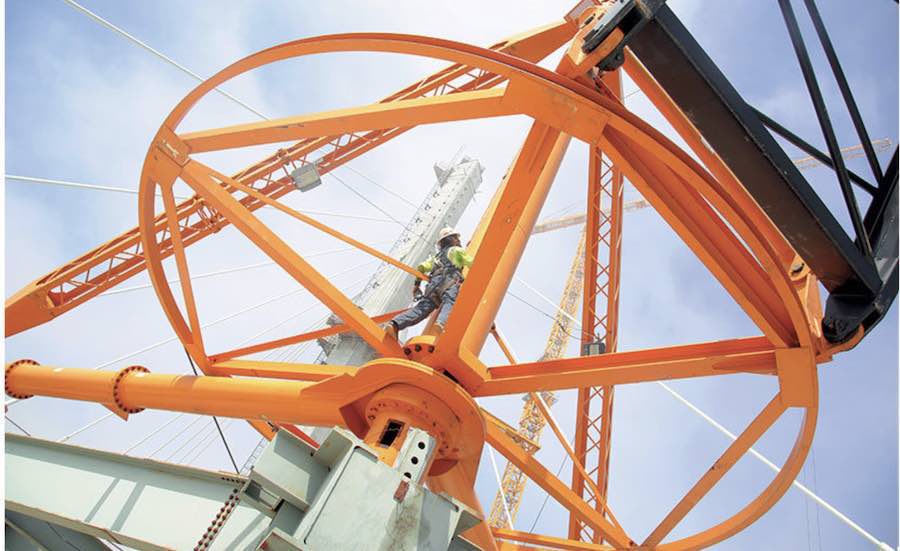Commentary
Editorial: How to Pass a True Infrastructure Bill
ENR editorial board's advice to Congress and the President

Workers at the Gerald Desmond bridge replacement in Long Beach, Calif. An ENR 2019 Year in Construction Photo Contest Winner by Marie Tagudena, staff photographer, Shimmick Construction.
The ironies are piling up fast in opening comments about the Biden administration infrastructure plan.
President Joe Biden cited investment in the federal highway system by Dwight D. Eisenhower, a Republican, in making the case for the plan. Ironically, Eisenhower was a small-government advocate who actually sought to push more spending to the states, but failed. Then there’s Senate Minority Leader Mitch McConnell, in the first of what will no doubt be many broadsides against the plan. He said that if the package was no more than a “Trojan horse” for a tax increase, count him as a skeptic.
We have only to point out that the prior Republican administration’s tariffs did little to add to domestic employment but drove up the cost of goods Americans purchased—essentially a new tax.
And finally there’s the Wall Street Journal, which tosses off the infrastructure plan and the taxes to fund it as Biden’s “climate-and-infrastructure binge.” The Journal should know, given its coverage of risky investment binges Wall Street remains prone to.
The Associated General Contractors and other industry groups have tried to untwist part of the policy pretzel, endorsing the infrastructure plan but rejecting the proposed increase in corporate income tax as the 'pay-for.'
The Associated General Contractors and other industry groups have tried to untwist part of the policy pretzel, endorsing the infrastructure plan but rejecting the proposed increase in corporate income tax as the “pay-for.”
Much of the overall annual federal investment, especially in measures passed in response to the 2009 financial crisis, has been directed to education and job training, including primary, secondary, and vocational instruction, and Pell grants for college students.
In 2018, the Congressional Budget Office reported that the U.S. spent $121 billion on non-defense education and training. That was more than the $110 billion spend that same year for non-defense physical capital, with $64 billion going for transportation.
One way to improve the Biden plan is to make it truly infrastructure-focused instead of an omnibus bill lacking coherence. The proposal includes a $400-billion section labeled “how we care,” which it calls the "care infrastructure." It pays for raising wages and benefits for home-care workers for the elderly or disabled. Another section is called ‘how we make and create,” for technological and scientific research, with a proposed cost of $580 billion.
ENR Washington D.C. bureau chief Tom Ichniowski counted only $990 billion for the sectors that ENR traditionally views as construction-related infrastructure—to be spent over an eight-to-10-year span.
This is the greatest irony of all—that the infrastructure bill spends so much, possibly the majority of the dollars, not on infrastructure but on scientific research and care for the elderly and disabled.
These are important aspects of America’s economy and quality of life and will create employment. But their inclusion in this proposal confuses its purpose and impact and further obscures the critical importance of infrastructure—from the electrical grid and water supply to schools, transit systems and electric vehicle charging stations—to U.S. economic recovery, global growth and every American's ability and right to prosper.
The Biden administration is corrrect to emphasize that now is a historic opportunity to remind Americans that government public works are essential to the public and do things that private industry cannot or will never do. We liked hearing Transportation Secretary Pete Buttigieg say the emphasis won’t be on speed and shovel-readiness, but on shovel-worthiness.
Wisdom about what will be built should come at the local level.
But the entire plan will be easier to stand behind if Democrats rise above the typical legislative sausage-making and provide a more cohesive single-purpose infrastructure measure. That’s what had to happen to pass COVID-19 relief legislation, to which Democrats had originally strapped a minimum-wage increase. The Senate Parliamentarian forced it out of the bill that eventually passed.
Doing something similar with the infrastructure bill—cutting packages devoted to research and home care—would help when it came time to decide whether infrastructure should be paid for with user fees rather than by higher corporate taxes now in the plan.
We don’t think that’s asking too much.




